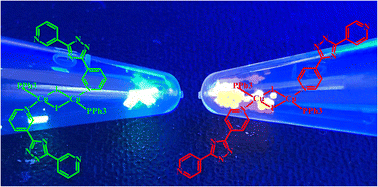Structure and emission properties of dinuclear copper(i) complexes with pyridyltriazole†
Abstract
A new series of five highly emissive binuclear heteroleptic pyridyltriazole-Cu(I)-phosphine complexes 1–5 was synthesized and examined by different experimental (IR, elemental and thermogravimetric analysis, single crystal X-ray diffraction technique, UV-vis and fluorescence spectroscopy) and quantum chemical aproaches. Complexes 1–5 exhibited excellent stimuli-responsive photoluminescent performance in the solid state at room temperature (quantum yield (QY) = 27.5–52.0%; lifetime (τ) = 8.3–10.7 μs) and when the temperature was lowered to 77 K (QY = 38.3–88.2; τ = 17.8–134.7 μs). The highest QY was examined for complex 3 (52%) that can be explained by the small structural changes between the ground S0 and exited S1 and T1 states leading to the small S1–T1 triplet gap and efficient thermally-activated delayed fluorescence. Moreover, complex 4 demonstrates reversible mechanochromic and excitation dependent luminescence.



 Please wait while we load your content...
Please wait while we load your content...